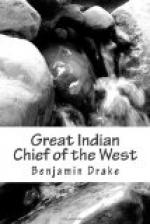“The Yengetongs and the Sessitongs inhabit the upper parts of the river St. Peters, and are sometimes called the Sioux of the plains. Their traffic is principally in Buffalo robes. The Wahpetongs, or people of the leaves are the most erratic in their dispositions of all the Sioux; they inhabit the St. Peters between the Prairie de Francois and the White Rock, during a part of the year, and generally go out to hunt above the falls of St. Anthony towards the sources of the river De Corbeau, and upon the plains which give origin to the Crow, Sac and Elk rivers.
“The Titongs inhabit both banks of the Missouri, and rove in quest of game over an immense extent of country. They are said to be related to the Mahas, and some other bands south of the Missouri.
“The Mendewacantongs, or people of the Medicine Lake, the Washpecontongs, or people of the Leaves, who have run away, and some other scattered bands, whose names are unknown, inhabit the country generally, from St. Peters south to the mouth of the Missouri, and are chiefly located upon the sources of the rivers Ocano, Iowa, and Desmoines.
“The Sioux are generally represented as a brave, generous and spirited people, with proud notions of their origin as a tribe, and their superiority as hunters and warriors, and with a predominant passion for war. They speak the Narcotah language, which is peculiar to themselves, and appears to have little affinity with any other Indian tongue. It is not so soft and sonorous as the Algonquin which abounds in labials, but more so than the Winnebago, which is the most harsh and guttural language in America. The Narcotah sounds to an English ear, like the Chinese, and both in this, and in other respects, the Sioux are thought to present many points of coincidence. It is certain that their manners and customs differ essentially from those of any other tribe, and their physiognomy, as well as their language, and opinions, mark them a distinct race of people. Their sacrifices and their supplications to the unknown God—their feasts after any signal deliverance from danger—their meat, and their burnt offerings—the preparation of incense, and certain customs of their females, offer too striking a coincidence, with the manners of the Asiatic tribes, before the commencement of the Christian era, to escape observation, while their paintings and hieroglyphics bear so much analogy to those of the Asteeks of Mexico, as to render it probable that the latter are of Naudowessian origin.”
“From my knowledge of the Sioux nation,” observes Lieutenant Pike, “I do not hesitate to pronounce them the most warlike and independent nation of Indians, within the boundaries of the United States, their every passion being subservient to that of war. Their guttural pronunciation, high cheek bones, their visages, and distinct manners, together with their own traditions, supported by the testimony of neighboring nations, put it in my mind beyond a shadow of doubt, that they have emigrated from the north west point of America, to which they had come across the narrow streights, which in that quarter divide the two continents; and are absolutely descendants of a Tartarean tribe.”




